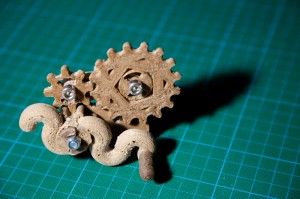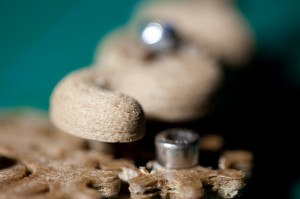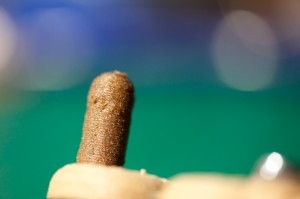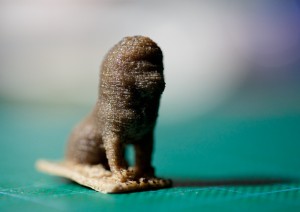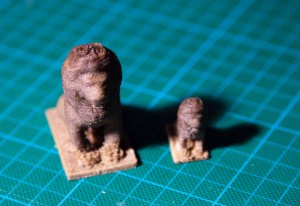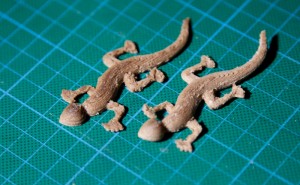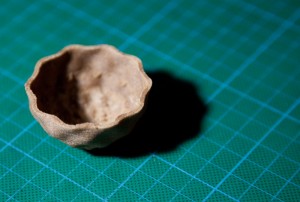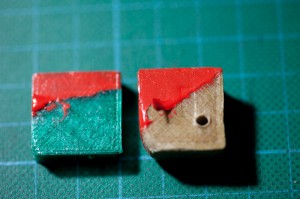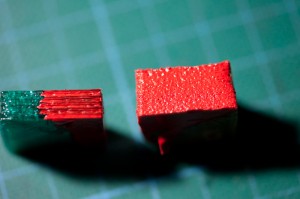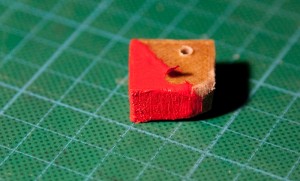More Wood Composite Observations
A quick post with a couple more observations on the wood composite together with some photos.
Sam's Gears
Whilst printing a tray of the excellent Sam's Gears by pleppik I wanted to reduce ooze so I increased the speed and also the temperature to 230°C, and midway the extruder jammed due to a blocked nozzle. At higher temperatures the composite turns darker and becomes harder, and it may have been this that caused the jam, or possibly some other detritus. It could also of course been caused by something other than the material, however this is the first time this nozzle has jammed. Generally going slower and cooler seems to be the best tactic.
Sam's Gears, Crank Detail
Sam's Gears, Gear Detail
Sam's Gears, Crank Handle Detail
The Venetian Lion by tbuser I printed scaled down 50% and 25%, and with support. The support came away quite easily, but I can't compare this to other materials as this was the first print I have done with support. The temperature was set to 220°C and layer height was 0.24, this produced a finish more akin to brown PLA rather than a "wood" finish.
Lion (50% scale) Detail
Lion (25% scale)
Lions (50% and 25% scale)
A couple of Simplified Gekko's by CodeCreations were next to test the hypothesis that visible layers look better with the wood finish. Whilst not terribly beautiful prints, the colour and texture detail, particularly of the heads, are quite pleasing.
Simplfied Gekko
Gekkos
Dizingof's Dragon Bowl came out quite nicely, but highlighted a problem which crops up frequently: the latest version of Slic3r seems to jump around a bit, particularly when infilling, and because of the ooze problem this results in imperfect finishes.
Dragon Bowl
I printed out 2 copies of the bowl, one at 220°C and another at 185°C. The latter is lighter in colour, this is also clearly visible in the Sam's Gears print, where the crank handle was printed cool, but the gears hot. Another property I am seeing: prints at lower temperature are much more compressible (spongy) and flexible. The pins I printed for Sam's Gears were so flexible they were not really usable (hence the bolts instead). The texture at lower temperature is also more "wooly" and woodlike. Several of the prints, such as the pin board, have quite a look of MDF about them.
Sam's Gears, Crank Detail
Whilst testing how paint applies to the material I realised that I hadn't yet tried painting regular PLA. Surprisingly, at least to me, the PLA also took the water-based acrylic paint I tried well too - so long as the surface was sanded beforehand. The wood composite took the paint well without sanding, apart from the bottom plane, which is quite glassy. This would need to be sanded before applying a coat, otherwise the paint peels off quite easily.
Paint Test, Glassy bottom, (PLA left, wood right)
Paint Test, Side, (PLA left, wood right)
Paint Test, Wood
Comments
-
Dimitrios
03-10-2012 01:03
Hi Gary
This is very interesting, thanks for sharing!
I bet this PolyBend02 thing from Thingiverse will look fabulous printed in this wood composite material.
Cheers!
-
Bob Morrison
22-10-2012 10:40
The Flintstones auto that WAS in Thingiverse (can't find it anymore) would look good printed in this material.
Gary, where are you located?
-
Gary Hodgson
22-10-2012 11:29
Yeah, that would be a good candidate. It's interesting that with a new material one automatically rethinks what models would be suitable - for example toys are a also good candidate for the wood composite (so long as it's kid safe).
I'm based in Karlsruhe - not too far from you if I remember rightly.
-
Robert H. Morrison
22-10-2012 12:38
Did you purchase the wood composite from the GRRF?
-
Robert H. Morrison
22-10-2012 12:45
Yes, of course you did, you mentioned it in a previous article! . . . Never mind!
